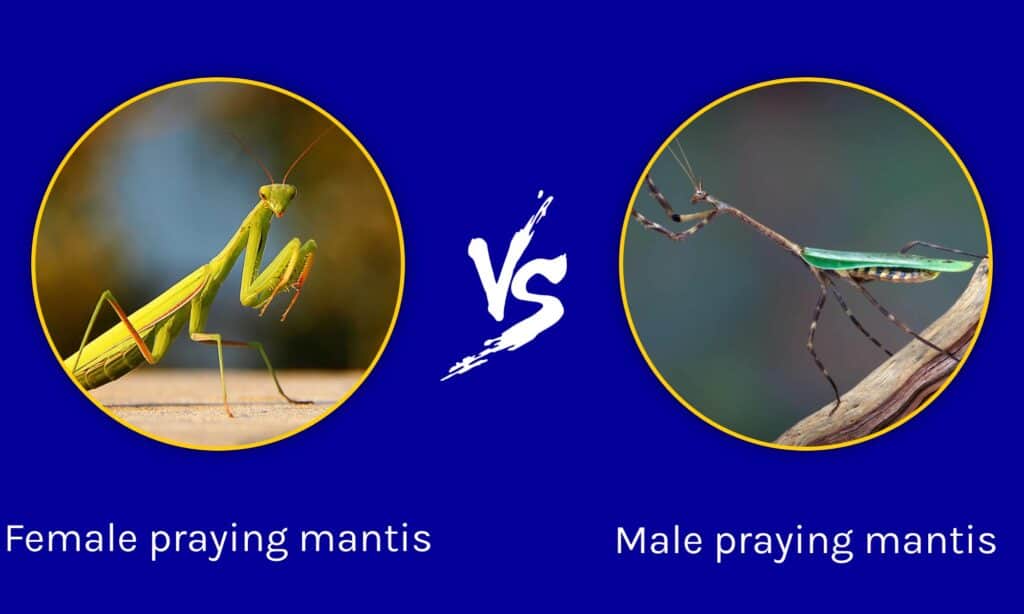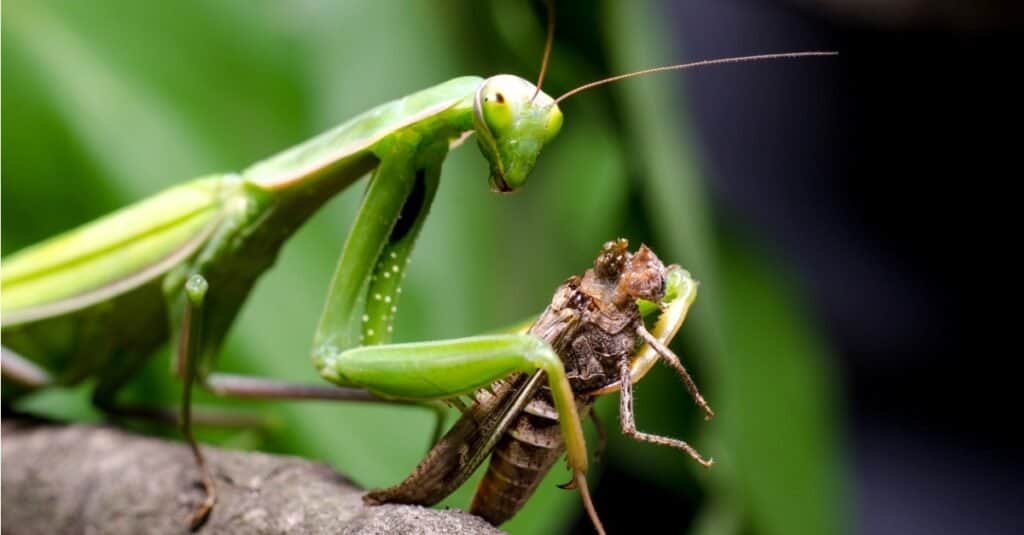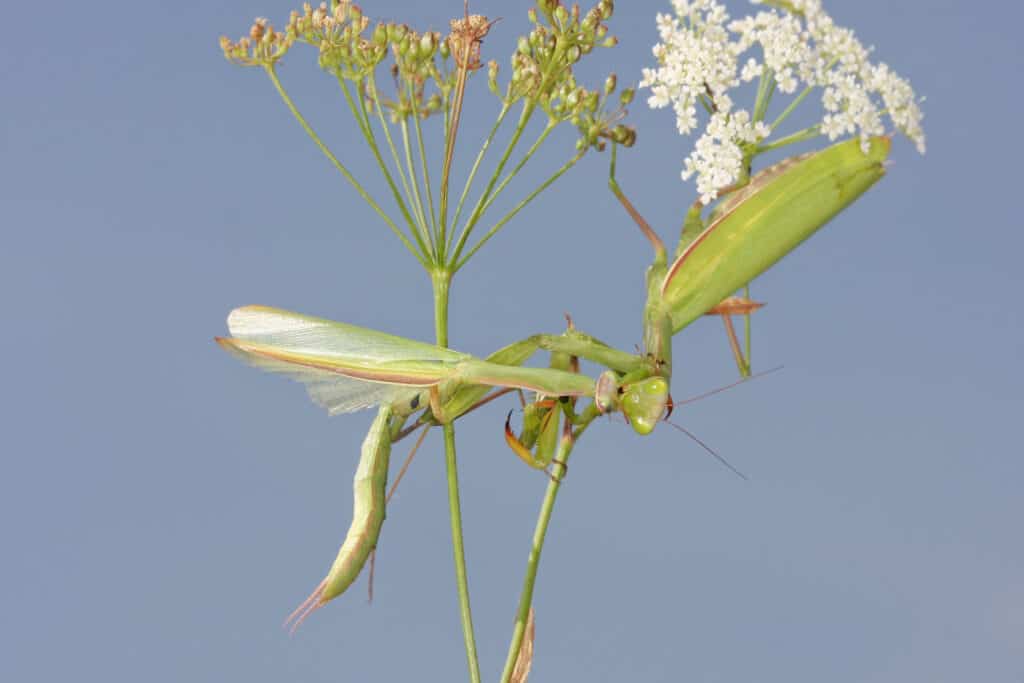The praying mantis gets its name from its posture – its bent front legs held together at an angle suggesting the position of prayer. The name is usually used to refer to the European species of mantises.
Though they look quite alike, there are very obvious differences between a male and a female praying mantis.
This article aims to show you what these differences are.
Comparing a Male Praying Mantis and a Female Praying Mantis

| Male Praying Mantis | Female Praying Mantis | |
|---|---|---|
| Body Size and Type | They are lean and thin They are about 3-4 inches in body length | They are thick and round They are about 6 inches in body length |
| Abdominal Segments | They have eight abdominal segments | They have six abdominal segments |
| Wings and Flying ability | They can fly | Most species can’t fly |
| Cannibalism | They do not practice sexual cannibalism | They practice sexual cannibalism occasionally |
| Antennae | They have long and thick antennae | They have thread-like antennae and shorter ones than males’ |
The Key Differences Between a Male Praying Mantis and a Female Praying Mantis
The most significant difference between a male praying mantis and a female praying mantis is their abdominal segments. Female praying mantises have six abdominal segments, while males have eight abdominal segments. The female abdominal segments are not equal, with the last segment usually the biggest.
On the part of the males, their abdominal segments are usually close to each other in size, though the final segments are usually smaller than the rest.
Let’s explore other differences in detail.
Male vs Female Praying Mantis: Body Size and Type

Male praying mantises typically measure around 3 to 4 inches long.
©iStock.com/artas
Female adult praying mantises have a bigger body size than males. Generally, females have an overall size of about 6 inches, while males have a body size that is smaller than that, about 3 to 4 inches long. Also, in order to carry eggs, the females are usually rounder and wider in the abdomen, which allows fat to accumulate and for the eggs to be fertilized.
Furthermore, in some species, there are color differences between the male and the female. For instance, with the Carolina mantis, females may be green, yellow, gray, or brown, while males are always grayish-brown with green legs.
Male vs Female Praying Mantis: Wings and Flying Ability
Most male praying mantises have longer wings than females, and while females are usually too heavy to take flight or do not need to fly, males can fly. Male praying mantises are smaller and thinner, therefore, the ratio between body mass and wings is optimized for flight.
Generally, praying mantises do not fly to hunt or search for prey, they would rather wait to ambush their prey. So if you see a praying mantis in flight, it is most likely a male in search of a female to mate – and they do this majorly at night.
Do Female Praying Mantis Bite?
The courtship of praying mantises can be quite aggressive if not fatal for males, as it is well-documented that females often engage in the act of decapitating and consuming various body parts of their male partners during mating. Nevertheless, it’s possible that the prevalence of such aggression may be slightly exaggerated.
Despite their petite size, praying mantises have been known to consume a variety of creatures, including spiders, frogs, lizards, and small birds. While praying mantises are not typically associated with biting humans, there is a remote possibility.
This could occur accidentally if they mistake a human finger for prey, although, like most animals, they generally have the ability to correctly discern their food sources.
Male vs Female Praying Mantis: Behavior
One major behavioral difference between the male and female praying mantis is that the females are more sedentary than the males. Of course, this is helped along by the fact that males fly frequently, and that it is the males that look for a mate while the females simply wait for the males to come.
Male vs Female Praying Mantis: Cannibalism

Female praying mantis eating male after mating.
©Geza Farkas/Shutterstock.com
Female praying mantises have been known to eat males during or after mating. According to scientists, female praying mantises that are not well-fed are more likely to engage in cannibalism.
Another experiment has also revealed that males and females may engage in battles before they mate, and the winner of the fight determines whether cannibalism occurs or not. Where the male wins the fight, the outcome of mating is less gory but where the female wins, then it is very likely that he will get eaten by the female after mating.
Male vs Female Praying Mantis: Antennae
Both male and female praying mantises have antennae that help them find food. However, males tend to have longer and thicker antennae than females. Female antennae look more like threads. The difference in the antennae may not be obvious at first, but they become more pronounced as they grow older.
Male vs Female Praying Mantis: Diet

Praying mantises are generalist carnivores. This means that will eat prey that they can handle. Some of their common victims include caterpillars, grasshoppers, cockroaches, flies, moths, and ants. To capture their prey, most mantises will engage in ambush, either by camouflaging themselves while staying stationary or by stalking their prey with stealthy and slow movements.
Once their prey is within reach, most mantises will grasp their prey with their spiked forelegs.
The photo featured at the top of this post is © Stefan Csontos/Shutterstock.com
Thank you for reading! Have some feedback for us? Contact the AZ Animals editorial team.






